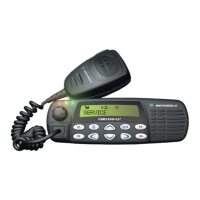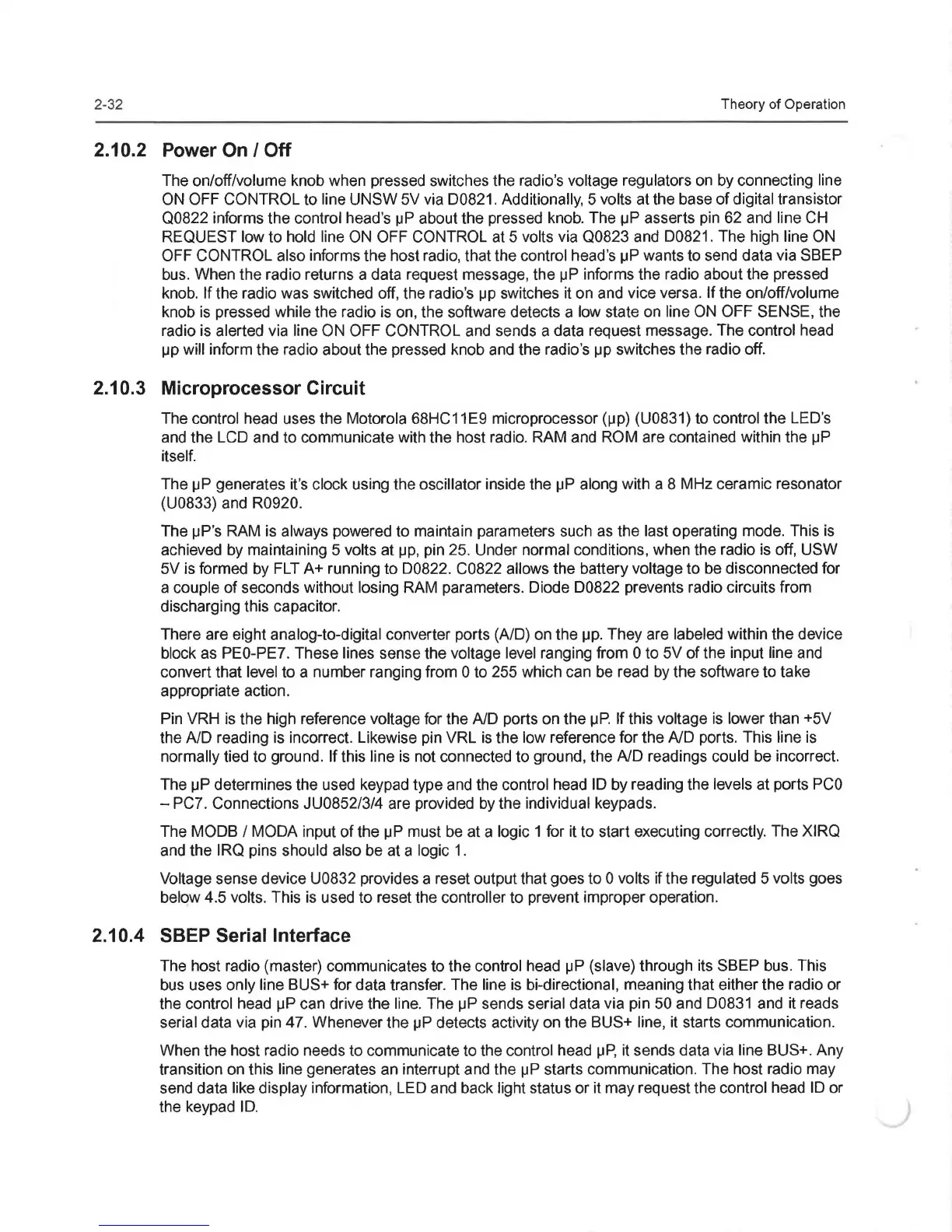2-32
Theory of
Operation
2.1
0.2 Power
On
I Off
The on/off/volume knob when pressed switches the radio's voltage regulators on by connecting line
ON OFF CONTROL
to line
UNSW
5V via D0821 . Additionally, 5 volts at the base
of
digital transistor
Q0822 informs the control head's
IJP
about the pressed knob. The
IJP
asserts pin 62 and line CH
REQUEST
low to hold line ON OFF CONTROL at 5 volts via Q0823 and D0821. The high line ON
OFF CONTROL also
informs the host radio, that the control head's
IJP
wants to send data via SBEP
bus. When the radio returns a data request message, the
IJP
informs the radio about the pressed
knob.
If
the
radio was switched off, the radio's
IJP
switches it on and vice versa. If the on/off/volume
knob is pressed while the radio is on, the software detects a low state on line ON OFF SENSE, the
radio is
alerted via line ON OFF CONTROL and sends a data request message. The control head
IJP
will inform the radio about the pressed knob and the radio's
IJP
switches the radio off.
2.1
0.3 Microprocessor Circuit
The control head uses the Motorola 68HC11 E9 microprocessor
(IJP)
(U0831) to control the LED's
and the LCD and to communicate with the host radio. RAM and
ROM are contained within the
IJP
itself.
The
IJP
generates it's clock using the oscillator inside the
IJP
along with a 8 MHz ceramic resonator
(U0833) and R0920.
The
tJP's
RAM is always powered to maintain parameters such as the last operating mode. This is
achieved by maintaining 5
volts at
IJP,
pin 25. Under normal conditions, when the radio is off, USW
5V is formed by FLT A+ running to D0822. C0822 allows the battery voltage to be disconnected for
a
couple
of
seconds without losing RAM parameters. Diode D0822 prevents radio circuits from
discharging this capacitor.
There are eight
analog-to-digital converter ports (A/D) on the
!Jp
. They are labeled within the device
block as PEO-PE7. These lines sense the voltage level ranging from 0 to 5V
of
the input line and
convert that
level
to
a number ranging from 0 to 255 which can be read by the software
to
take
appropriate action.
Pin VRH is the high reference voltage for the AID ports on the
IJP.
If this voltage
is
lower than +5V
the
AID reading is incorrect. Likewise pin VRL
is
the low reference for the AID ports. This line is
normally tied to ground.
If
this line
is
not connected to ground, the AID readings could be incorrect.
The
IJP
determines the used keypad type and the control head ID by reading the levels at ports
PCO
-PC?.
Connections JU0852/3/4 are provided
by
the individual keypads.
The
MODB I MODA input
of
the
IJP
must be at a logic 1 for it to start executing correctly. The XIRQ
and the IRQ pins should also be at a logic 1.
Voltage sense device U0832 provides a reset output that goes
to
0 volts if the regulated 5 volts goes
below 4.5 volts. This is used
to
reset the controller to prevent improper operation.
2.1
0.4 SBEP Serial Interface
The host radio (master) communicates to the control head
IJP
(slave) through its SBEP bus. This
bus uses
only line BUS+ for data transfer. The line is bi-directional, meaning that either the radio or
the
control head
IJP
can drive the line. The
IJP
sends serial data via pin 50 and D0831 and it reads
serial data via pin 47. Whenever the
IJP
detects activity on the BUS+ line, it starts communication.
When the host radio needs
to
communicate
to
the control head
IJP,
it sends data via line BUS+. Any
transition on this
line generates an interrupt and the
IJP
starts communication. The host radio may
send data
like display information, LED and back light status or it may request the control head
ID
or
the keypad
ID.

